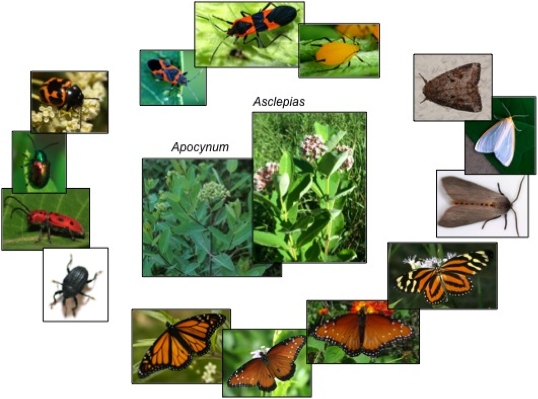1. Understanding genetic basis of novel adaptive trait and constrains of adaptive evolution through convergent evolution
What is the genetic basis of novel adaptive traits?
If similar adaptive traits evolved independently in multiple lineages, do they evolve through similar genetic changes? Level of molecular convergence could indicate level of constrains of adaptation and tell us how predictable adaptive evolution is.
We study convergent evolution of toxic cardiac resistance across insects under a variety of ecological context to understand both genetic basis and evolution of toxin resistance and factors that could constrain adaptive evolution.
Published work:
Tianyu Wang, Lina Shi, Ying Zhen. Gut-Specific Cardenolide-Resistant Sodium Pump Primed an Omnivore to Feed on Toxic Oleander. IScience (2022) 25 (12): 105616.
Ying Zhen, Matthew L Aardema, Edgar M Medina, Molly Schumer, Peter Andolfatto. Parallel molecular evolution in an herbivore community. Science (2012), 337:1634-7.
Matthew L. Aardema, Ying Zhen, Peter Andolfatto. The evolution of cardenolide-resistant forms of Na+,K+-ATPase in Danainae butterflies. Molecular Ecology (2012), 21(2): 340-9.
Research news:

2.New method to quantify and compare the amount of adaptive evolution across species
Does the amount of adaptive evolution vary across species? If so, what factors determine the pattern of variation? To answer this, first question is how to formally quantify the amount of adaptive evolution. We developed a new model-based approach to better estimate the amount of substitutions fixed by adaptive evolution between species, and to estimate the proportion and strength of new beneficial mutations. Using this new method, we quantify and compare the amount of adaptive evolution among different species and estimated that at least 20% of nonsynonymous substitutions between humans and chimpanzee were fixed by positive selection, much higher than previous estimates. We also found greater strength of selection and higher proportion of new beneficial amino acid changing mutations in humans compared to mice and Drosophila melanogaster.
Ying Zhen#, Christian D. Huber, Robert W. Davies, Kirk E. Lohmueller#. Greater strength of selection and higher proportion of beneficial amino acid changing mutations in humans compared with mice and Drosophila melanogaster. Genome Research (2021). 31:110–120.
3.Understanding patterns of genomic diversity in natural populations across environmental gradients.
How do populations of a species adapt to various environments? The genetic diversity of a populations is shaped by various evolutionary forces, including population history, migration, and selection. In turn, by examining the genetic diversity of natural populations, we could infer their history and find genetic basis of their adaptation to local environment. The results could help to prioritize conservation decisions and predict how climate change would impact current populations. Under this theme, I have been working on natural populations of a community of species across a rainforest-ecotone gradient in Central African rainforest through international collaborations. The research provides new insights and strategies to prioritize geographic regions for protection.
Published work:
Ying Zhen*#, MichelK. Dongmo*, Ryan J. Harrigan, Kristen Ruegg, Qi Fu, Rachid Hanna, Timothy C. Bonebrake, Thomas B. Smith. Strong habitat-specific phenotypic plasticity but no genome-wide differentiation across a rainforest gradient in an African butterfly. Early online in Evolution.
Adam H. Freedman, Ryan J. Harrigan, Ying Zhen, Alison M. Hamilton, Thomas B. Smith. Ecotone Speciation Across an African Rainforest-Savanna Gradient. Early online in Mol Ecol.
Thomas B. Smith, Trevon L. Fuller, Ying Zhen, Virginia Zaunbrecher, Henri A. Thomassen, Kevin Njabo, Nicola M. Anthony. Genomic vulnerability and socio-economic threats under climate change in an African rainforest bird. Evolutionary Applications (2021). Volume14, Issue5, May 2021, Pages 1239-1247
Katy Morgan, Jean-François Mboumba, Stephan Ntie, Patrick Mickala, Courtney A Miller, Ying Zhen, Ryan J Harrigan, Vinh Le Underwood, Kristen Ruegg, Eric B Fokam, Geraud C Tasse Taboue, Paul R Sesink Clee, Trevon Fuller, Thomas B Smith, Nicola M Anthony. Precipitation and vegetation shape patterns of genomic and craniometric variation in the central African rodent Praomys misonnei. Proceedings of the Royal Society B (2020) 287 (1930), 20200449.
Ying Zhen#, Ryan J. Harrigan, Kristen Ruegg, Eric C. Anderson, Thomas C. Ng, Sirena Lao, Kirk E. Lohmueller, and Thomas B. Smith. Genomic divergence across ecological gradients in the Central African rainforest songbird (Andropadus virens). Molecular Ecology (2017). 26, 4966–4977
Ying Zhen#, Preeti Dhakal and Mark C. Ungerer. Fitness benefits and costs of cold acclimation in Arabidopsis thaliana. American Naturalist (2011), Vol. 178, No. 1, pp. 44-52.
Ying Zhen, Mark C Ungerer. Relaxed selection on the CBF/DREB1 regulatory genes and reduced freezing tolerance in the southern range of Arabidopsis thaliana. Molecular Biology and Evolution (2008), 25(12):2547-55.
Ying Zhen, Mark C Ungerer. Clinal variation in freezing tolerance among natural accessions of Arabidopsis thaliana. New Phytologist (2008) 177 (2), 419–427.
Fei He, D Kang, Y Ren, Li-Jia Qu, Ying Zhen and Hongya Gu. Genetic diversity of the natural populations of Arabidopsis thaliana in China. Heredity (2007) 99, 423–431